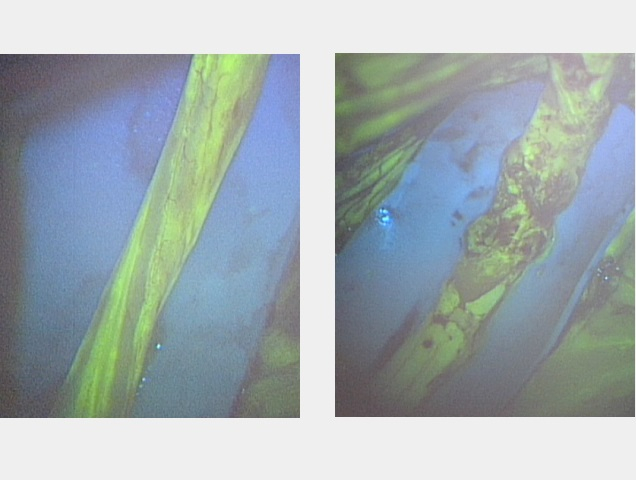Research News
Oct 10, 2024
- Medicine
Glowing approach could aid carpal tunnel-related surgery
Fluorescein angiography capable of assessing neural blood flow in chronic nerve compression neuropathy
Visualizing nerves
Fluorescein-enhanced contrast imaging shows a rabbit’s normal sciatic nerve, left, and a damaged one.
Credit: Osaka Metropolitan University

In modern office life, avoiding the onset of carpal tunnel syndrome might be a daily struggle. The worst case could mean needing surgery to alleviate compression of the nerves or to repair damaged nerves. Helping surgeons visually check the areas where neural blood flow has decreased due to chronic nerve compression can lead to improvements in diagnostic accuracy, severity assessments, and outcome predictions.
With this in mind, an Osaka Metropolitan University-led research team involving Graduate School of Medicine student Kosuke Saito and Associate Professor Mitsuhiro Okada investigated the use of fluorescein angiography, a method employed in neurosurgery and ophthalmology to highlight blood vessels, to visualize neural blood flow in chronic nerve compression neuropathies like carpal tunnel syndrome.
The team found that fluorescein angiography could detect a decrease in neural blood flow in rats and rabbits with chronic nerve compression neuropathy. The results also correlated with electrodiagnostic findings.
Then fluorescein angiography was used for human patients undergoing open carpal tunnel release surgery, and the data also correlated strongly with electrodiagnostic testing. The findings indicate that fluorescein angiography might possess high diagnostic capabilities to assess neural blood flow during surgery.
“In surgery for severe chronic nerve compression neuropathy, the surgeon’s experience plays a big role in judging whether the surgical range is appropriate or whether additional treatment is necessary,” graduate student Saito noted. “This research has shown that fluorescein angiography can visualize impaired areas and assess the impairment severity, so we believe that it has the potential to contribute to improving accuracy for related surgeries.”
The findings were published in Neurology International.
Paper information
Journal: Neurology International
Title: Fluorescein Angiography for Monitoring Neural Blood Flow in Chronic Nerve Compression Neuropathy: Experimental Animal Models and Preliminary Clinical Observations
DOI: 10.3390/neurolint16050074
Authors: Kosuke Saito, Mitsuhiro Okada, Takuya Yokoi, Shunpei Hama, Hiroaki Nakamura
Published: 5 September 2024
URL: https://doi.org/10.3390/neurolint16050074
Contact
Mitsuhiro Okada
Graduate School of Medicine
Email: m-okada[at]omu.ac.jp
*Please change [at] to @.
SDGs
